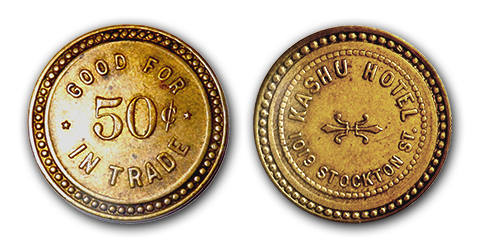The Kashu Hotel
by Jerry F. Schimmel
The tokens and history of The Kashu Hotel in San Francisco
Sakutaro Nakano (pronounced sah-KOO-tah-ro nah-KAH-no) appeared neatly dressed in Federal Circuit Court on June 29, 1918, charged with “unlawfully, willfully and knowingly keeping a house of ill-fame at 1019 Stockton Street known as Hotel Kashu.” San Francisco Police Officer Patrick Walsh testified that he visited the Kashu frequently as part of his duties and had seen women in and around the premises who, when questioned, “had no occupation.” Lieutenant Charles Goff of the Morals Squad declared that he knew “the general reputation of the place. It is a house of prostitution.” Nakano denied that he received money from anyone except legitimately registered occupants, though further testimony suggests he was present on some occasions when women brought in non-registered male visitors who were visible through a small window.
The hotel was situated at 1019 Stockton Street between Washington and Jackson streets on the west side and opened first in 1913. The structure extended in the rear to James Alley and counted 75 rooms, 60 upstairs and 15 on the mezzanine. A single room cost $1.40 a day and meals could be included for an extra charge. A space on the mezzanine was occupied by a cigar and candy stand. Four retail shops unrelated to the hotel occupied the ground floor. The original building still stands with slightly different street numbers but remains identifiable with its dark brown brick facade. Today it serves as single resident occupancy apartments.

The brass token shown was used to pay for a meal and obtained at the front desk. Its legend reads: Kashu Hotel, 1019 Stockton St., Good For 50¢ In Trade. It is 28mm diameter. No other denominations are known.
The Kashu was located on what was then the western edge of San Francisco’s Chinatown. Chinatowns of the West often provided lodging for others of East Asian ancestry like Japanese, Koreans and Filipinos. African-Americans and Latinos as well who could not find rooms in white districts often stayed in these ethnically mixed hostelries which were scattered all over the country.
Nakano was the hotel’s founding owner, a Japanese immigrant who owned 140 acres of tomatoes and corn in Contra Costa County and served as a part time shipping agent for the Toyo Kisen Kaisha Oriental Steamship Company, later becoming president of the Japanese Hotel Association in San Francisco. He came to California around 1900 and married 18-year-old Matsuye Isoda in 1910. The couple lived with their children in the Kashu alongside the culturally mixed clientele. Given Nakano’s wide responsibilities, his time spent in management of the hotel must have been minimal.
From my own studies the Kashu could not have been remotely compared to the cribs and parlor houses existing prior to 1917, not with several families in resident, children running loose in the halls and a fair number of older single men and women of all backgrounds coming and going at all hours. So, it seems a few rooms were informally commandeered for adult fun and games. Court testimony suggested there were other hotels in the area operating under similar circumstances.
Nakano was largely affected by two events: San Francisco’s closing of the city’s brothels on Valentine’s Day in 1917, and the U.S. entry into World War I on April 6 of the same year. The declaration of war included an executive order stating there could be no prostitution within five miles of any military installation. The Presidio, Fort Mason, Fort Winfield Scott, Fort Baker, Fort McDowell, Hunter’s Point Naval Shipyard, and the Yerba Buena Island Naval Training Station were among those affected.
In Nakano’s case, three enterprising African-American women having lost their base of operations the year before moved to The Kashu immediately, posing as normal guests meanwhile letting old clients know they were still in business. They took to leaning out windows and calling to men on the sidewalk, that is when they weren’t out walking the pavement.
Nakano was found guilty as charged but appealed and was exonerated. It was not clear what happened to the day-to-day hotel managers who no doubt received cash tips when the ladies brought their companions upstairs. He became a leader in San Francisco’s Japanese community with close ties to Japan’s embassy and consulate and, with them, sponsored local Japanese cultural programs. In 1928 he moved The Kashu name to Japantown which he gave to a corner building at 1701 Laguna Street, later demolished during the 1960s Fillmore District redevelopment.
Within weeks after the bombing of Pearl Harbor in December 1941, nationwide arrests of Japanese-Americans began with President Roosevelt’s Executive Order 9066 requiring that all Japanese-ancestry residents, citizens or not, be removed from Pacific coastal areas and relocated farther inland forcing them to abandon property and careers. The edict did not apply to Hawaii. In the process of relocation, the lives of all evacuees were ruined. Nakano and his family were among them.
Bibliography
- San Francisco City and Telephone Directories 1900-1950
- Federal Circuit Court papers December 1918